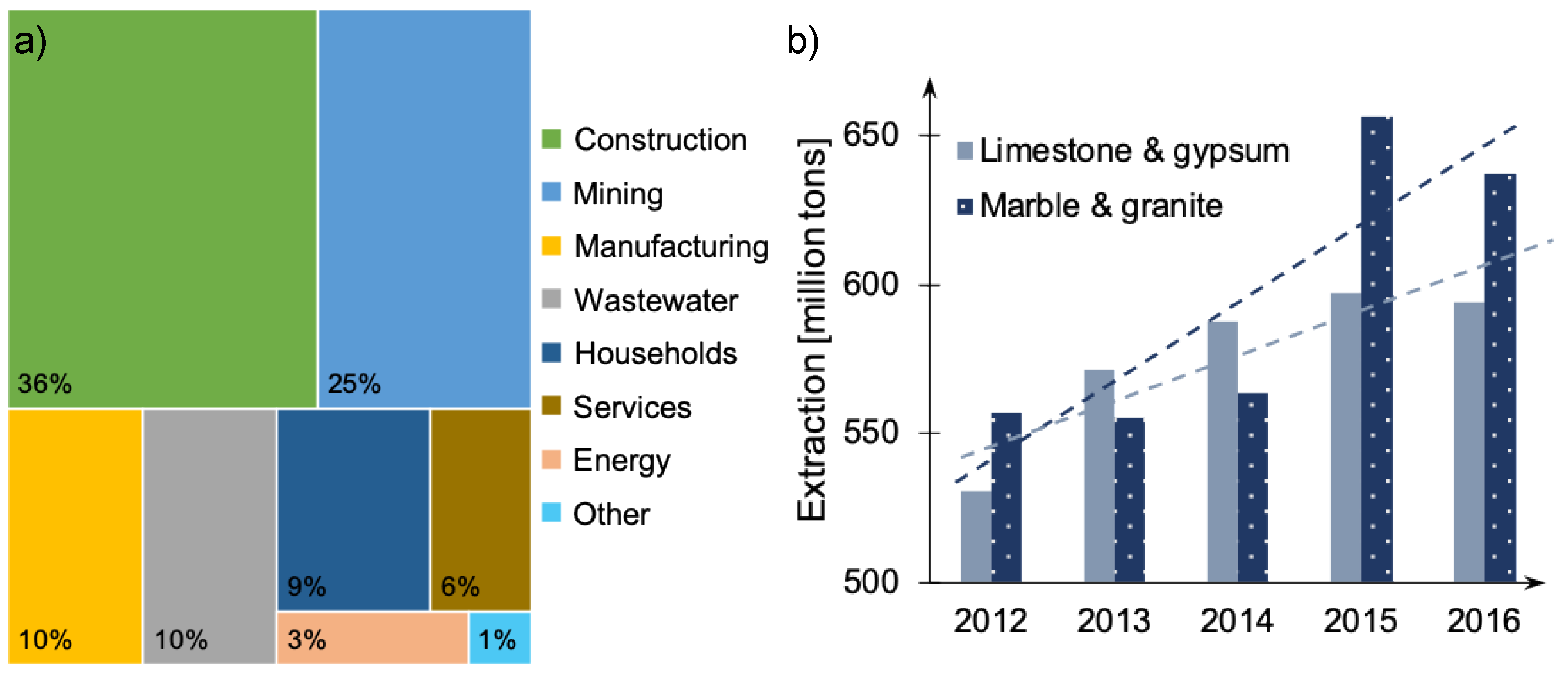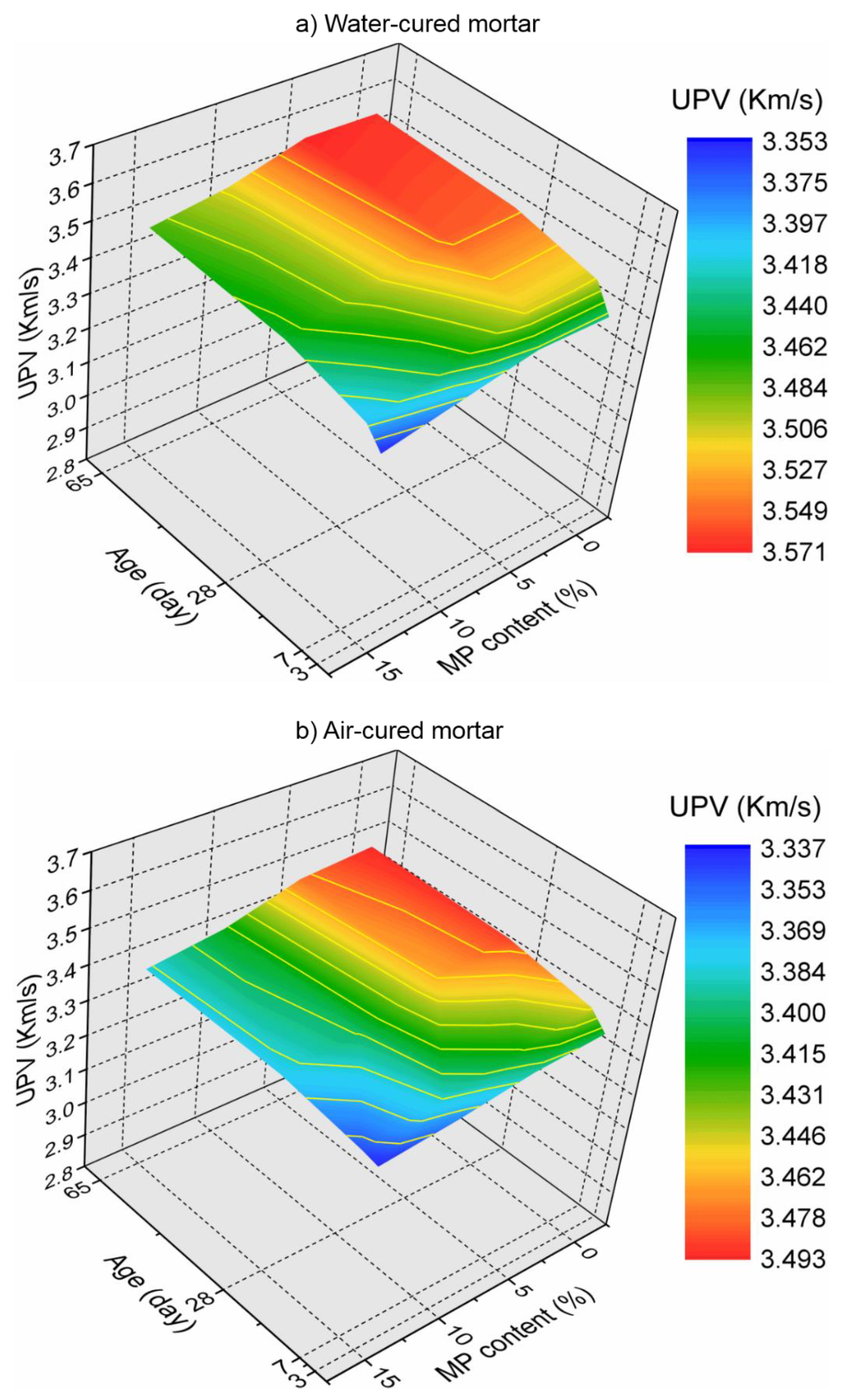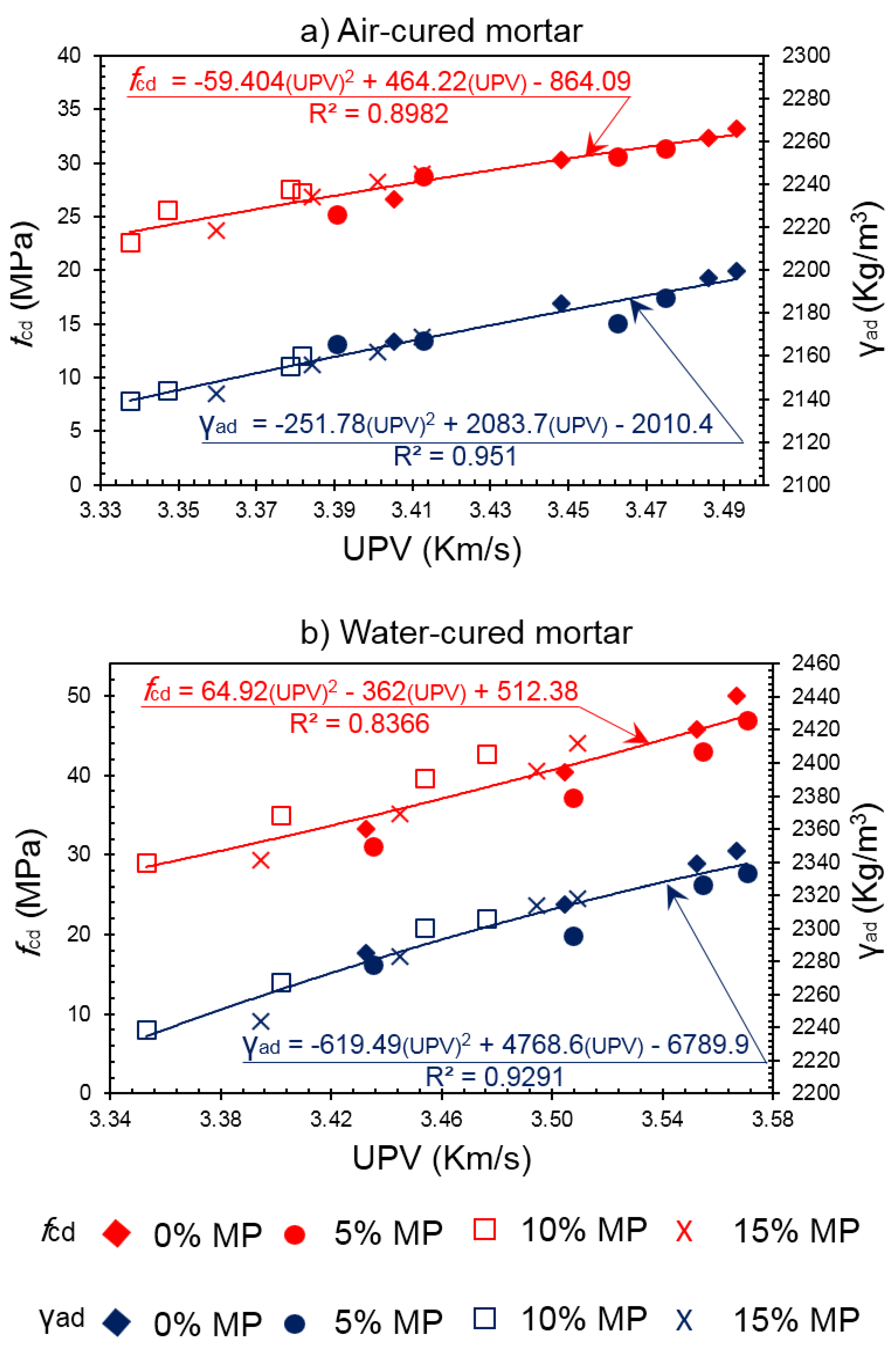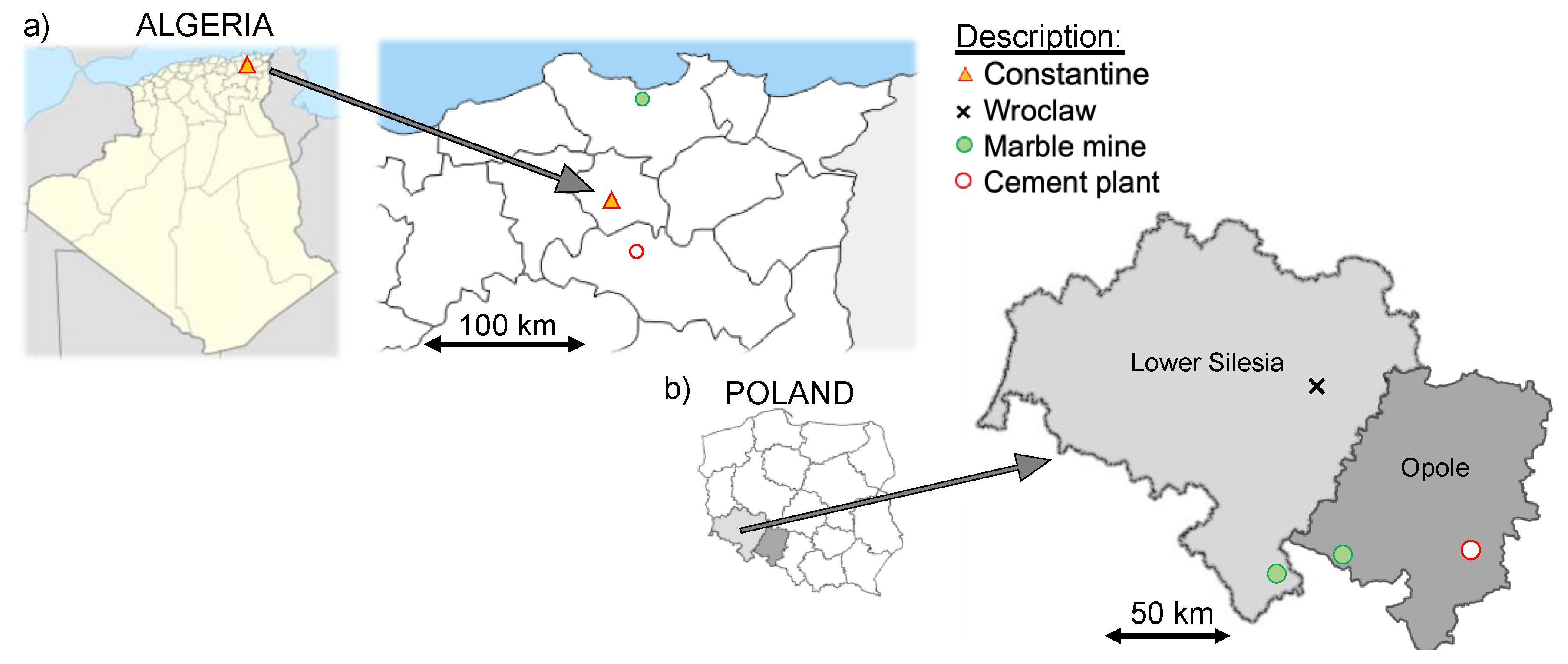1. Introduction
To evaluate the quality of cement-based building materials, there are several tests that can be conducted such as destructive or non-destructive tests. The non-destructive test is the simplest test and can be used in most of the places, in comparison, in the real site it is very limited to use the destructive test. The ultrasonic pulse velocity (UPV) test is one of these non-destructive tests. The UPV test gives the results on site and predicts a preliminary idea about the value of the compressive strength and the porosity of cement-based building materials. The UPV test depends on several parameters such as the type and the content of cement, the type and the volume of aggregates, the type of admixture, the amount of water, the initial wetting condition, and the age of curing, it also depends on the interfacial transition zone (ITZ) between aggregate and cement paste, the density and the porosity of the cement paste, and the characteristics of aggregates [
1]. The UPV test performed on standard concrete is very well described in literature [
2,
3].
Waste generation is a current problem that affects most of countries around the globe. Construction and mining industry are responsible for generating around 1566 million tons of wastes per year. This is more than a half of all wastes generated in 2016 in European countries (
Figure 1a). Increasing amount of new planned constructions for building causes a need for higher extraction of raw materials for the preparation of e.g., concrete. Cement, one of the most important components in concrete, consists of heated limestone and clay minerals with the addition a few percent of gypsum. Extraction of limestone and gypsum increased in last few years and in 2016 it was equal 594 million tons. Similar phenomenon has been observed for marble and granite with 637 million tons of raw materials extraction in 2016 (
Figure 1b). High amount of wastes generated during mining extraction must be transported to be stored in special places. Many processes are needed to control and manage the wastes which negatively affect the environment (e.g., transportation, storing, disposal). There is need to look for new possibilities of use of these wastes.
In the last few years, an interest toward the mineral wastes has appeared due to their harmful impact on the environment [
4,
5] by introducing them in the manufacture process of the cementitious materials. The use of these wastes is a matter of great importance from environmental and economic points of view [
6]. The marble powder (MP) is one of these mineral wastes which was used in this study as a partial substitution for cement. Replacement of cement by MP wastes could allow to reduce limestone and gypsum extraction with benefits for the environment.
By checking the available literature related to the utilization of MP as a cement replacement in cementitious materials using the destructive tests, most of the studies concluded that the MP has the desired effect on the improvement of the selected fresh and hardened properties, and the durability of the cementitious materials [
7,
8,
9,
10]. For instance, the addition of MP in mortar matrix up to 10% of replacement ratio contributed to an improvement in the fresh properties such as the workability [
8,
11] and the mechanical properties such as the compressive strength of composite mortar [
12,
13], whereas Mohamadien [
14] and Aliabdo et al. [
2] found this improvement to be continued up to 15% of MP replacement ratio. For the addition of MP in the cement paste, the physical and the mechanical properties of the cement paste contains MP up to 20% of replacement ratio were improved [
15].
In addition, several studies were performed on the addition of the MP in cementitious materials using the non-destructive tests, Demirel [
16] studied the effect of using waste marble dust as a fine sand on the mechanical properties of the concrete by performing the UPV, porosity, and compressive strength tests, the results indicate that the UPV increased with increasing percentages of marble dust. This is due to the MP that features by a micro-filler effect that helps in forming a dense mix by filling the voids [
13]. While the utilization of MP in self-compacting concrete as cement replacement led to decrease the UPV values [
2,
3,
4,
5,
6,
7,
8,
9,
10,
11,
12,
13,
14,
15,
16,
17], it was concluded that this decrease is due to the reduction of C
3S and C
2S in cement paste [
15] which reduces the volume of hydrated products. Other studies [
2,
18] have shown that the utilization of MP as cement or sand replacement has an insignificant effect on the UPV values of concrete.
Most of studies performed the UPV test on the concrete incorporated the MP as replacement of cement or sand. For the best of our knowledge, there is no study related to the UPV evaluation on cement paste and mortar made with MP as cement replacement in different curing condition, and as a continuity research task of the previous destructive evaluations on cement paste [
19,
20] and mortar [
21], the UPV test is herein adopted as a non-destructive method for the evaluation of the mechanical properties of cement paste and mortar.
In the present study, both destructive and nondestructive tests were performed for the purpose of validating the experimental results that were obtained from the destructive tests. In addition, an empirical relationship between the nondestructive and destructive test was determined in order to predict the mechanical and physical characteristics of cement paste and mortar blended with marble powder. Furthermore, the economical aspect of the study was shown in terms of the price of transport from marble mine and cement plant to the construction sites and the price of composite materials (
Figure 2).
2.2. Methods
Characterization of the Cement, Marble Powder, and Sand
The chemical analysis of the Portland cement, marble powder and sand was performed using Zetium-X-ray Fluorescence Spectrometry technique, the results are presented in
Table 1.
The physical properties of these materials include: specific gravity, bulk density, Blaine fineness, were determined using: the pycnometer method, apparatus with a sieve funnel and tripod, a unit weight measure of 1-L capacity, a spatula, a straight edge and an aluminum scoop, and Blaine apparatus, respectively.
The experimental research passes through two parts; the first one is related to the preparation of cement composites using Portland cement replaced by marble powder at certain proportions (0%, 5%, 10%, and 15%), and the second part is related to the preparation of mortar using the previously mentioned proportions of marble powder as cement replacement. The physical and mechanical properties of the prepared materials were determined.
In order to determine the apparent density, the UPV and the compressive strength values, for each replacement ratio, six cubes (50 × 50 × 50 mm3) of cement paste and six cubes (50 × 50 × 50 mm3) of mortar were prepared, the water-to-binder ratio was kept at 0.4 and 0.5, respectively in all mixes. The samples were divided into two groups, the first group was cured in tap water 20 ± 1°C and the second was stored at an air temperature equal to 22 ± 2 °C and a relative humidity of about 20 ± 1%, all specimens were tested at 3, 7, 28, and 65 days.
When reaching the test’s age, the apparent density
ϒad is the first parameter that was determined, it was calculated by the following equation [
23]:
where:
ϒad: apparent density (g/cm
3);
md: mass of dry specimen (g); and
V: total volume of dry specimen (cm
3).
Then the ultrasonic pulse velocity (UPV) of cement paste was determined by using the ultrasonic instrument of brand “CONTROLS” UPV value was calculated by the following equation [
16]:
where
V is the ultrasonic pulse velocity in m/s;
h is the distance between the edge surfaces of the cement-based specimen sent wave and the received wave in meter;
t is the time gap that the ultrasonic waves need to move from the surface of cement-based specimen sent ultrasonic wave to the surface of cement-based specimen received wave in µs.
The compressive strength (fcd) test was conducted using Digimax plus 70-C0019/B machine of brand “CONTROLS” and its maximum capacity is 1000 KN. This test was performed after determining the UPV values.
3. Results
The results of different tests such as apparent density, UPV and compressive strength are presented in
Table 2 and
Table 3. The presented values were calculated as the average of six specimens for each test. The UPV values as a function of MP content, curing condition and curing ages are presented in
Figure 4 and
Figure 5. In addition, the increase and decrease rate of compressive strength, UPV, and apparent density of mortar containing MP are presented in
Table 4 and
Table 5.
3.1. Apparent Density and Compressive Strength
The hardened properties of cement paste and mortar specimens cured in two different conditions (water and air) were evaluated to analyze the effects of using MP as cement replacement, the apparent density (
ϒad) and the compressive strength (
fcd) were tested at different ages (at 3, 7, 28, and 65 days). The results are illustrated in
Table 2 and
Table 3, respectively.
As can be shown in these tables, the macroscopic properties of cement pastes and mortars were affected by using the MP as a cement replacement content of 0%, 5%, 10%, and 15% in both curing conditions.
In both curing conditions, the compressive strength (fcd) and apparent density (ϒad) were increased with an increase of curing period and decreased with increasing amounts of MP.
The
ϒad slightly decreases by increasing the MP content at all curing ages and in both curing conditions compared to the control cement paste or mortar. This could be attributed to the presence of ultrafine particles [
19,
21], which contribute to the decrease in the
ϒad of the matrix, also to the specific gravity of the MP, which is lower than that of the PC [
15,
24,
25].
From the results presented in
Table 4 and
Table 5, it can be stated that the water-cured samples showed a higher decrease of
ϒad and
fcd than the air-cured samples. However, these properties have higher values in the case of water-cured composites comparing to the air-cured composites.
From the same
Table 2 and
Table 3, it can be seen that the
fcd decreases with an increasing amount of MP up to 15%, which means that the MP does not have pozzolanic properties. This decline could be attributed to the decrease of
ϒad. In addition, it may be due to the significant reduction of clinker content in the mixtures [
2,
5,
26,
27].
From these results, it can be stated that the mortar containing 5% of MP shows a compressive strength value at 28 days close to the nominal compressive strength of the PC used (42.5 MPa). Similar results were found in the previous study of [
12]. The authors indicated that the use of MP in amounts of 7.5%, and 10% as a cement replacement causes a decrease of at 28 days by 10% and 14%, respectively.
In the previous discussed results, it was shown that the apparent density and the compressive strength of both, cement paste and mortar specimens, were affected by changing of the curing conditions.
As can be seen in
Table 2 and
Table 3, the
ϒad and the
fcd of the cement paste and the mortar specimens cured in air were lower than those cured in water. This is due to the lower volume of hydrated products, as the compounds of cement required water for 28 days to complete the hydration process. In addition, the air curing condition caused water evaporation from a fresh cement-based building material [
28] and thus led to an incomplete hydration process.
3.2. Ultrasonic Pulse Velocity
The UPV results of cement paste are given in
Table 2 and presented in
Figure 4. It is clear that the UPV was affected by the incorporation of MP as a partial replacement of cement, and it was observed that the UPV increases with an increase in curing duration.
In case of water-cured cement paste, it is observed (
Figure 4a) that the UPV slightly increased with an increase of MP up to 10% as cement replacement at all curing ages. This could be explained by the effect of this inert addition as ultrafine aggregates filling voids [
29], which enhances the properties of transition zone surrounding aggregate [
2]. While 15% of MP replacement led to a decrease in the UPV at all curing ages, this may be due to the high decrease in the clinker content of the cement mix.
On the contrary, when the samples of cement paste are cured in air (
Figure 4b), the results showed that the UPV values slightly decreased with the increase of MP up to 15% at all curing ages. This could be explained by the decrease in the volume of hydration products, due to the reduction of mineralogical compositions of cement-based materials (especially: C
2S and C
3S), as well as the storing condition of samples in air, which causes the evaporation of water leading to an incomplete hydration process, and thus a decrease in the apparent density and compressive strength, and an increase in the porosity of cement matrix.
The decline in UPV was attributed to the decrease of
ϒad, the ultrasonic pulses in this case required more time to pass in the length of the solid material [
30]. In addition, this can be explained by the increase of porosity due to the decrease of hydrate products resulting from the use of MP as a cement replacement [
20].
Regarding the UPV results of mortar (see
Table 3 and
Figure 5), it can be seen that water-cured mortar (
Figure 5a) containing MP up to 5% has a similar UPV value comparing to the control mortar at all curing ages. This can be explained as mentioned previously for water-cured cement pastes. Whereas using MP more than 5% led to a slight decrease of this parameter. This is may be due to the water accumulating around MP grains which leads to reduce the water required for 28 days to complete the hydration process of cement grains and therefore resulting in an increase in the porosity. In addition, it may also be mainly due to the trapped air that formed when Portland cement and sand aggregates are mixed with MP [
21] creating air voids. However, when the incorporation level of MP is slightly higher such as, 10% and 15% of the cement’s weight, the UPV decrease as a corresponding result. This trend is found because MP grains may increase the distance between the grains of cement and slightly increase the total voids between the grains of cement, the latter one is generated because MP slightly decreases workability [
21] and more water is required to obtain the same slump as the equivalent conventional mortar. This behavior decreases the density of the cement paste, increases the total voids between the cement grains, and thus decreases the UPV.
In the case of air-cured mortar (
Figure 5b), the UPV decreases with corresponding increase amounts of MP up to 15% due also to the three reasons were mentioned previously. In addition, it could also be related to the storing condition of samples in air, which causes a high water evaporation rate of mortar specimens, leading to an incomplete hydration process, and thus increases the porosity of cement matrix.
The increase and decrease rate of UPV are presented in
Table 4 and
Table 5, it can be stated that the air-cured samples showed a higher decrease of UPV than the water-cured samples. However, in the case of water-cured, using 5% and 10% MP in cement paste and 5% MP in mortar led to an increase of UPV value.
Finally, it can be stated that the UPV not only depends on the apparent density but also depends on the total voids content in the cement-building materials.
3.3. Relationship between UPV, Compressive Strength, and Apparent Density
Figure 6 and
Figure 7 show the relationship between compressive strength and UPV, apparent density and UPV of cement paste and mortar in both curing conditions, respectively. Each graph consists of two polynomial equations, the first equation (
fcd as function of UPV) represents the relationship between the compressive strength and the UPV, whereas the second equation (
Yad as function of UPV) represents the relationship between the apparent density and the UPV.
It is clear from these figures that the hardened properties of cement pastes and mortars containing MP have a good relationship in both curing conditions. The obtained equations can be used regardless the MP content.
Generally, the trend in UPV is to increase with increasing of compressive strength and apparent density for all mixtures at all curing ages and in both curing conditions.
It can be concluded that, the compressive strength can be over-estimated by performing the UPV test only as a non-destructive test, the presented polynomial equations proved a powerful tool of estimation with a coefficient of determination ranging from 0.83 to 0.95 even by taking in consideration of the variation of the MP content and the age of the test application.
3.4. Economic Performance of Waste Marble Powder Used in Cement Paste and Mortar
The compressive strength of the cement paste and mortar slightly decreased with increased addition of MP. Cement paste and mortar are not used as structural materials, therefore their strength reduction caused by replacement of cement by MP could not have significant impact on potential use of this material. Therefore, reduction of harmful influence on the environment by substitution of cement by MP wastes is valid and should be performed in the places where it is possible (near marble mining). Thus, the additional purpose of this study was to analyze the economic performance of waste marble powder used in cement paste and mortar. High amounts of the new buildings in Algeria located near a marble mine are built in Constantine (
Figure 8a) and in Poland (in Lower Silesia-southwest region of Poland) they are built in Wroclaw (
Figure 8b). These locations were chosen as a target place for the assessment of distances between material suppliers and the potential cities where the analyzed material can be used. The transport costs in 2019 (5.18 × 10
−5 $/(km⋅kg)) were estimated by average transport costs offered by DELLATM Trucking INC. The considered distances are as follows:
from marble mine (National Marble Institution Factory Enamarbre, Skikda, Algeria) to Constantine—90 km,
cement plant located in Boussouf, Constantine (Hamma Bouziane Cement Factory),
from closer marble mine (Marmur Sławniowice LLC, Slawniowice, Poland) to Wroclaw—101 km,
from cement plant (Górażdże Cement Inc, Chorula, Poland) to Wroclaw—114 km.
For the calculations, different costs of the cement were used (cost of cement in: Algeria 0.071
$/kg; Poland 0.089
$/kg). The MP as a waste material can be obtained without bearing the costs. The transportation cost was included and presented in
Table 6 for each analyzed sample and country.
It is visible from
Table 6 that with higher addition of MP the total costs are decreasing. From economic point of view, even when cement plant is located closer to the potential location of use than marble mine, it is cheaper to substitute partially cement with MP. However, this solution should be chosen in the situation when the storing place for the wastes is located in a farther distance than potential location of use.
4. Conclusions
During the development of this research study and from the results and analyzes, it can be mentioned that the use of grinded marble powder as a cement replacement up to 10% in the production of cement paste and mortar allows to reduce environmental problem and save more natural resources.
In construction practice, it may be economically sensible to use marble powder as cement replacement for non-structural elements in building, it can be used in tiles, edge sidewalk, and roof coating. This suggestion is due to the low density of marble powder compared to that of ordinary Portland cement. From the obtained results, the following conclusions can be drawn:
In both curing conditions, the compressive strength and apparent density of cement paste and mortar decreases as the incorporation of MP increases.
The type of curing condition affects the macroscopic and microscopic properties of the cement pastes and mortars. The water-curing conditions resulted in higher apparent density and compressive strength of cement paste and mortar containing MP as a partial replacement of cement compared with the air curing conditions.
The UPV of cement paste and mortar was affected by the incorporation of MP as a partial replacement of cement, and it was observed that the UPV grew with an increase in curing conditions.
In the case of air-cured cement paste and mortar, the UPV decreases as the incorporation of MP increase, this is may be due to two reasons: the substantial decrease of clinker content in the mixture and the water accumulating around MP particles which leads to reduce the water required for the hydration of cement grains and therefore resulting an increase in the porosity.
In the case of water-cured cement paste, the UPV increase as the incorporation of MP increase up to 10%, this may be due to the act of the MP as filler material, which enhances the properties of transition zone surrounding aggregate.
In the case of water-cured mortar, the UPV increase as the incorporation of MP increase up to 5%, whereas using MP more than 5% led to decrease the UPV due to the trapping air during the mixing process that creates air voids. In addition, this may be due to the water accumulating around MP grains which leads to an incomplete hydration process and therefore resulting in an increase in the porosity.
The UPV not only depends on the apparent density but also depends to the total voids content in the cement-building materials.
The relationship between the UPV, apparent density and compressive strength was satisfied.
From an economic point of view, higher addition of MP led to decrease of the total cementitious materials costs.
Partial substitution of cement with MP allows to reduce cement extraction with reduction of harmful impact on the environment of generated wastes, their transportation, and storing need. Additionally, the proposed solution has economic justification. However, it can be used mostly for non-structural materials and in the places located near a marble mine.
To summarize, the results indicate the possibility of using MP as a cement substitution up to 10% when the samples are cured in water.














